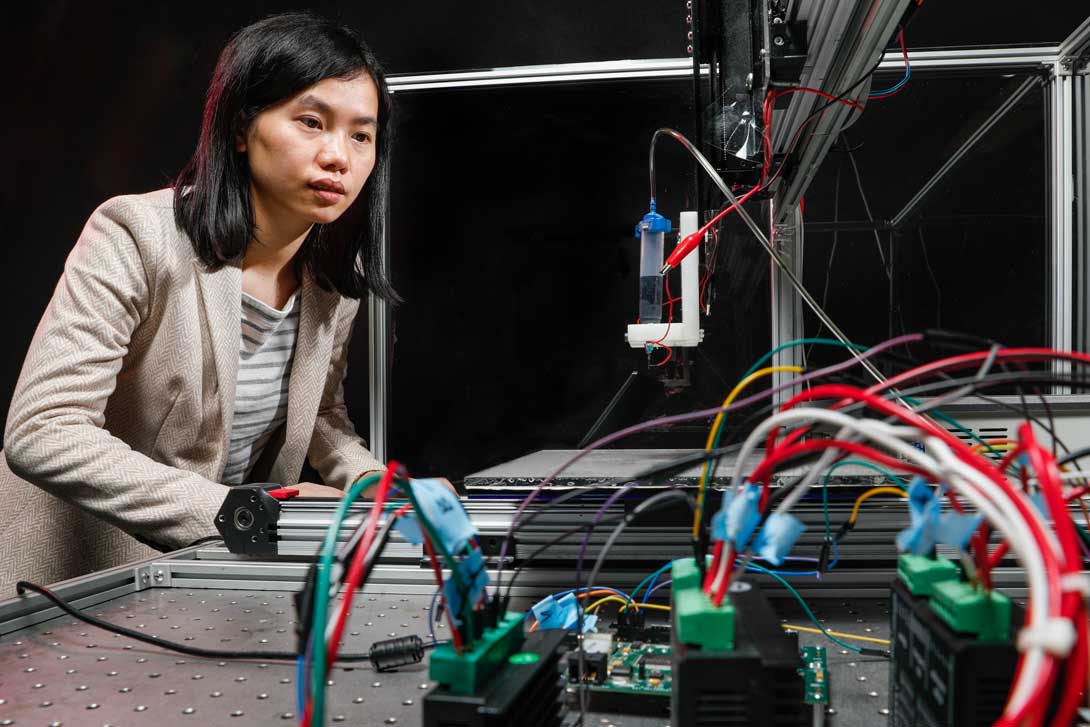A simpler e-textile manufacturing process

Imagine a textile that can monitor muscular activity during a workout, transmit data for the military, help with space exploration, or detect pathogens for medical treatments. This is just a small sample of what electronic textiles or e-textiles can do. They are the future of clothing in an industry that is growing by leaps and bounds.
E-textiles are fabrics that can conduct electricity and enable smart systems capable of sensing, heating, lighting, or transmitting data. While e-textiles offer an endless array of advantages there is one major obstacle holding them back from surging into a billion-dollar industry that needs to be addressed – the fabrication process.
A common approach to fabricating e-textiles is to construct conductive filaments and then knit or weave the filaments into fabrics. Another manufacturing approach is to fabricate conductive films and strips and then laminate them on fabrics using adhesives or hot pressing.
Despite recent advances, the existing manufacturing processes involve multiple steps and platforms that are usually tedious, slow, and have limited resolution and geometric complexity.
Improving the process through collaboration
In an effort to improve the method for making e-textiles, Associate Professor Yayue Pan and UIC Distinguished Professor Alexander Yarin, both of mechanical and industrial engineering, have teamed up to simplify the process. The research is supported by a National Science Foundation grant titled “A Study of Electric Field-Assisted Direct Ink Writing with Conducting Polymers for Electronic Textiles (E-textiles).”
This is the second collaborative project between the two professors and it’s a continuation of the previous collaborative project, which was also a National Science Foundation grant.
“Our collaboration is quite in-depth, and my group mainly focuses on the manufacturing process and ink synthesis,” Pan said. “Yarin’s group is focused on the electric field effects and the ink flow dynamics.
Yarin has a great deal of expertise in electrohydrodynamics, which is a part of fluid mechanics where an electric field affects the liquid behaviors. His team also has a substantial amount of expertise in textiles and fabrics.
“We want to understand the physical mechanism of the enhancement of the electrical conductivity of a conducting polymer blended with a non-conducting polymer,” Yarin said. “We also want to enhance as much as possible direct ink writing of conducting polymers on different substrates – including knitted and nonwovens – by means of applying the electric field.”
“For this project, we are investigating fundamental aspects to provide the needed knowledge for developing a rapid e-textile manufacturing technology, which directly prints highly conducting inks through a nozzle onto non-conducting fabrics and textiles,” said Pan.
To achieve this goal, they plan to study how to design the machine, including a way to embed an electric field, create the components for the special ink writing, and discover how to control the manufacturing process.
Weaving in new techniques
“We’re not working with a commercial machine,” Pan said. “It doesn’t exist for what we are doing. For the first task, we will investigate the machine design and develop a prototype.”
Currently, the team is using a syringe barrel to hold the ink and extrusion is controlled using the syringe pressure controller. It’s like writing on paper using a pen. In addition to that, electrodes are added by the extrusion nozzle to create an electric field to enhance and facilitate ink extrusion and deposition.
“After printing samples on varying fabrics, we will investigate the printed ink’s electrical conductivity,” Pan said. “We want to thoroughly examine the manufacturing process parameters and the chemical compositions of the ink. This will allow us to decide how to manipulate the compositions of the ink and how to plan the manufacturing process in a way that we can fabricate electrically conducting circuits on fabrics with a high resolution, high accuracy, and high conductivity.”
“There is no specific type of fabric or textile we are going to use. On the contrary, we are interested in demonstrating the electrically assisted direct ink writing on the roughest fabrics like knitted jute,” added Yarin. “We want to be able to deposit conducting polymer circuits onto any substrate. This should become doable for commercial shirts. Moreover, the latter are of significant interest, because different healthcare or health control electronic devices could be written on them.”
Once the researchers have the results they want, they plan to print different types of circuits for sensing applications that are already on the market. For example, there are commercial products available for shoe insoles that collect body data or activity data for sports applications or medical applications. Another possible application would be for heating application on a specific area of the fabric.
The short- and long-term impact
As the e-textile industry continues to grow, the researchers see their work as a game changer that will influence many people in different industries around the world.
“I think in the short term, we will create new knowledge that will be disseminated in the science community,” said Pan. “Based on the findings of our research, I think more people will follow, and this could create a long-term impact.”
“The industry needs the community collaborative efforts to change it and evolve,” she added.
In addition, this work will create opportunities for students to participate in research, get training in the manufacturing field, and receive training in multi-disciplinary areas such as material science, mechanical engineering, data analytics, and machine design.
“I think that’s the other major contribution we can have to change our world,” she said.
Giving back to the community
In addition to providing new information to scientists and industry, the research will benefit younger students. The project meets the educational needs of under-represented minority groups in the Chicago area and elsewhere, by engaging and training students and encouraging their participation.
Pan and Yarin host lab tours during open houses and summer camps at UIC. Pan has also received a Research Experiences for Undergraduates supplement grant for paying undergraduate students to participate in this project.